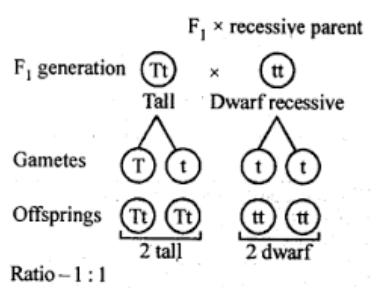
Answer
462.6k+ views
Hint: A test cross is known as a cross between an individual expressing a dominant trait with the one having its homozygous recessive trait in order to determine whether the dominant trait is homozygous or heterozygous.
Complete answer:
A cross between an organism with unknown genotype and a recessive parent is known as test cross. It is considered as a way to explore the genotype of an organism. The test cross was used earlier as an experimental mating test to determine the presence of alleles in the genotype. The genetic makeup of an organism is called its genotype, and it reflects all of the alleles (forms of the gene), that are carried by the organism. Subsequently, a test cross can help to analyse whether a dominant phenotype is homozygous or heterozygous for a specific allele. If the progenies produced by a test cross express 50% dominant trait and 50% recessive trait, then it is confirmed that the unknown individual is heterozygous for the trait. On the other hand, if the progeny produces a dominant trait, then the unknown individual is homozygous for the trait.
Example:
When a tall plant (TT) is crossed with dwarf plant (tt), in the F1 generation only heterozygous tall plants (Tt) appear. When these plants are crossed with homozygous recessive (tt) or dwarf plants, it is known as test cross. In the diagram given below, a test cross between tall heterozygous F1 hybrid with dwarf homozygous recessive parent produces tall and dwarf in equal proportion demonstrating that F1 hybrids are heterozygous.

Hence, the correct answer is option (B).
Note: A test cross basically involves mating an unknown genotypic individual with a known homozygous recessive parent. This happens because recessive alleles will always be masked by the presence of dominant alleles. Hence the phenotype of any offspring will imitate the genotype of the unknown parent. It can be used to know whether a dominant phenotype is homozygous or heterozygous.
Complete answer:
A cross between an organism with unknown genotype and a recessive parent is known as test cross. It is considered as a way to explore the genotype of an organism. The test cross was used earlier as an experimental mating test to determine the presence of alleles in the genotype. The genetic makeup of an organism is called its genotype, and it reflects all of the alleles (forms of the gene), that are carried by the organism. Subsequently, a test cross can help to analyse whether a dominant phenotype is homozygous or heterozygous for a specific allele. If the progenies produced by a test cross express 50% dominant trait and 50% recessive trait, then it is confirmed that the unknown individual is heterozygous for the trait. On the other hand, if the progeny produces a dominant trait, then the unknown individual is homozygous for the trait.
Example:
When a tall plant (TT) is crossed with dwarf plant (tt), in the F1 generation only heterozygous tall plants (Tt) appear. When these plants are crossed with homozygous recessive (tt) or dwarf plants, it is known as test cross. In the diagram given below, a test cross between tall heterozygous F1 hybrid with dwarf homozygous recessive parent produces tall and dwarf in equal proportion demonstrating that F1 hybrids are heterozygous.

Hence, the correct answer is option (B).
Note: A test cross basically involves mating an unknown genotypic individual with a known homozygous recessive parent. This happens because recessive alleles will always be masked by the presence of dominant alleles. Hence the phenotype of any offspring will imitate the genotype of the unknown parent. It can be used to know whether a dominant phenotype is homozygous or heterozygous.
Recently Updated Pages
10 Examples of Evaporation in Daily Life with Explanations

10 Examples of Diffusion in Everyday Life

1 g of dry green algae absorb 47 times 10 3 moles of class 11 chemistry CBSE

What is the meaning of celestial class 10 social science CBSE

What causes groundwater depletion How can it be re class 10 chemistry CBSE

Under which different types can the following changes class 10 physics CBSE

Trending doubts
Fill the blanks with the suitable prepositions 1 The class 9 english CBSE

Which are the Top 10 Largest Countries of the World?

How do you graph the function fx 4x class 9 maths CBSE

Who was the leader of the Bolshevik Party A Leon Trotsky class 9 social science CBSE

The Equation xxx + 2 is Satisfied when x is Equal to Class 10 Maths

Differentiate between homogeneous and heterogeneous class 12 chemistry CBSE

Difference between Prokaryotic cell and Eukaryotic class 11 biology CBSE

Which is the largest saltwater lake in India A Chilika class 8 social science CBSE

Ghatikas during the period of Satavahanas were aHospitals class 6 social science CBSE




